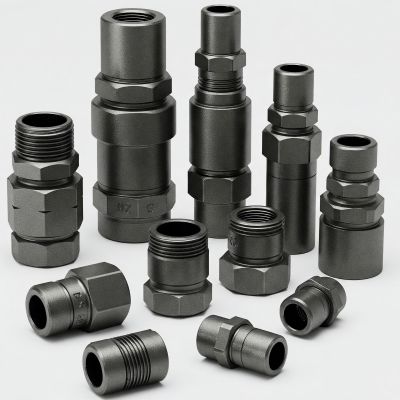Fasteners such as screws, bolts, and nuts play a crucial role in construction, manufacturing, and DIY projects. These components come with different thread types, with coarse and fine threads being the two primary variations. Choosing the right thread type is essential for ensuring strength, durability, and ease of use in any application.
This article explores the key differences between coarse and fine threads, their advantages, and the best applications for each type.
What Are Threads in Fasteners?
Threads are helical structures wrapped around the cylindrical body of a fastener, allowing it to secure materials together. These spiraled ridges create mechanical resistance and help in the fastening process.
Pitch and Thread Count
Pitch refers to the separation between a bolt’s or screw’s threads. On the other hand, thread count measures the number of threads per inch (TPI) in imperial units or threads per millimeter in metric units.
Coarse threads have a lower TPI (fewer threads per inch), while fine threads have a higher TPI (more threads per inch).
Why Thread Type Matters
Selecting the correct thread type impacts the strength, durability, and efficiency of fasteners in engineering, construction, and DIY applications. The right choice ensures a secure hold and prevents issues such as stripping, loosening, or breakage.
Coarse Threads: Characteristics and Benefits
Coarse threads have a wider pitch, meaning they have deeper and fewer threads per inch. This design makes installation quick and simple.
Common Materials Used with Coarse Threads
Coarse threads are often used with softer materials, such as wood, plastic, and softer metals like aluminum.
Advantages of Coarse Threads
➡️ Faster installation: Requires fewer turns to drive into a material.
➡️ More resistant to wear and damage: Less prone to thread stripping or cross-threading.
➡️ Better for softer materials: The deeper threads provide a stronger grip in wood and plastic.
➡️ Performs well in dirty or corrosive environments: Less likely to clog with debris, making them ideal for outdoor and rugged applications.
Common Applications
➡️ Woodworking and carpentry – Used for fastening wood materials.
➡️ Construction and framing – Ideal for structural and framing applications.
➡️ Machinery and heavy equipment – Suitable for large fasteners that require quick assembly and disassembly.
Fine Threads: Characteristics and Benefits
Fine threads have a smaller pitch with more threads per inch, resulting in a tighter and more precise hold.
Typically Used Materials with Fine Threads
Fine threads are commonly used with harder materials such as steel, iron, and other durable metals.
Advantages of Fine Threads
➡️ Stronger hold and greater tensile strength: The higher thread engagement enhances grip and load-bearing capacity.
➡️ More precise adjustments: Allows for fine-tuned torque control.
➡️ Better vibration resistance: The increased contact area makes them less likely to loosen over time.
➡️ Suitable for harder materials: Prevents stripping when used in strong metals.
Common Applications
➡️ Automotive and aerospace industries – Used in vehicles, aircraft, and high-performance machinery.
➡️ Precision instruments and machinery – Essential for applications requiring fine adjustments.
➡️ Metalworking and industrial applications – Common in metal structures requiring strong and secure fastening.
Key Differences Between Coarse and Fine Threads
|
Feature |
Coarse Thread |
Fine Thread |
|
Thread Pitch |
Larger |
Smaller |
|
Strength |
Less tensile strength, but more shear strength |
Higher tensile strength, lower shear strength |
|
Speed of Installation |
Faster |
Slower |
|
Resistance to Vibrations |
Less resistant |
More resistant |
|
Application |
Wood, soft materials, general-purpose use |
Metal, precision applications |
How to Choose Between Coarse and Fine Threads
When selecting between coarse and fine threads, consider the following factors:
➡️ Material Type: Coarse threads work well with softer materials, while fine threads are ideal for harder metals.
➡️ Load-Bearing Needs: Fine threads provide better tensile strength, whereas coarse threads excel in applications with shear forces.
➡️ Environmental Conditions: Coarse threads are better for dirty, corrosive, or rugged environments, while fine threads hold up well in controlled settings.
➡️ Ease of Installation: Coarse threads install quickly and require less precision, making them better for general-purpose use.
Conclusion
Understanding the differences between coarse and fine threads is essential for selecting the right fastener for your project. Coarse threads offer speed, durability, and better performance in softer materials, while fine threads provide a stronger hold, better vibration resistance, and are suited for harder materials.
By considering material type, load requirements, and environmental factors, you can choose the best thread type to ensure a secure and long-lasting connection in your applications.
Post time: Apr-23-2025



